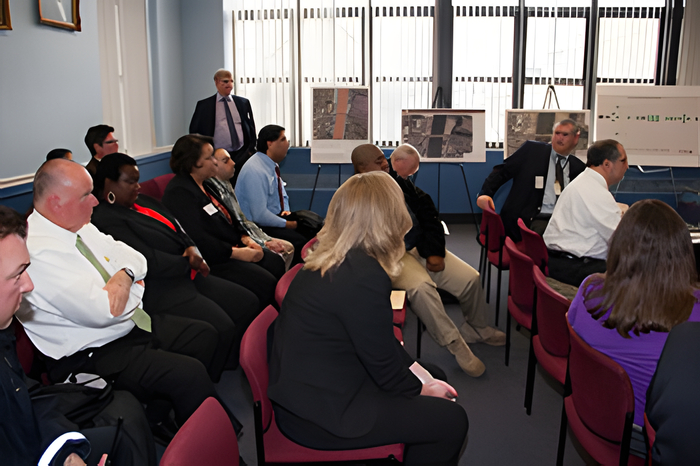FAQs
Presently, the Clay Street Bridge is over 100 years old and has structural and functional limitations that don’t meet today’s design standards. Due to its age, the bridge has deteriorated over time and routine maintenance can no longer address the deficiencies.
Age and deterioration, increased traffic volume and loads (weight of vehicles), and the potential for storms to disrupt normal operations are some of the reasons why this bridge no longer operates well and is in need of major rehabilitation or replacement if it is to continue to function and provide a viable crossing of the Passaic River connecting Clay Street in the City Newark, Essex County and Central Avenue in the Borough of East Newark, Hudson County. Both are identified as important roadways for the local communities and the region.
The project is currently in the Local Preliminary Engineering (LPE) phase. The LPE phase involves performing engineering and environmental tasks and documentation in order to obtain National Environmental Policy Act (NEPA) clearance for the project. Based on the Preliminary Preferred Alternative (PPA), a number of activities are simultaneously set in motion: community involvement (meetings with affected property owners or business owners), agency consultation, environmental documentation, design level mapping and design services. To inform and to encourage community consensus, community stakeholder and public information center meetings will be conducted, which may lead to refinements of the approach roadway intersections of the PPA. The Borough of East Newark and the City of Newark will be asked to maintain the resolutions of support for the PPA and for any design refinements.
The tasks conducted during the LPE Phase consist of, but are not limited to:
- Technical Environmental Studies (including Section 106 and Section 4(f) Evaluation)
- NEPA Document (Categorical Exclusion)
- Development of design level base plans
- Utility discovery and verification
- Geotechnical studies for foundation and pavement design
- Preliminary drainage work
- Structural studies that document the structural selection process and the recommended structure and aesthetic treatments
- Access impact evaluation
- Development of property acquisition cost estimates and project cost estimates
The following is the tentative overall project schedule:
- Local Concept Development Study – completed Spring 2020
- Local Preliminary Engineering Phase – current, Fall 2023 – Fall 2025
- Final Design Phase – anticipated Winter/Spring 2026 – Spring 2028
- Construction Phase – anticipated Fall 2028 – TBD (Bridge design dependent)
LPE Project Schedule (Major Milestones)
| Environmental Documentation Completed | Fall 2025 |
| Submission of Local Preliminary Engineering Report | Summer 2025 |
| Completion of Local Preliminary Engineering Phase | Fall 2025 |
LPE Anticipated Community Involvement Schedule
| Local Officials Meetings | Winter 2024, Spring 2025 |
| Community Stakeholders Meeting | Spring 2024 |
| Public Information Center Meeting | Spring 2025 |
A Local Concept Development (LCD) Study is the first phase of the Local Capital Project Delivery Process for transportation improvements. During this phase a well-defined and well-justified Purpose and Need Statement was developed focusing on the need to improve safety and maintain the current crossing over the Passaic River. The LCD phase elements also include data collection; coordination with the New Jersey Department of Transportation (NJDOT), Federal Highway Administration (FHWA), in addition to local officials, community stakeholders, the general public as well as permitting agencies; the development of a reasonable number of sensible and practical conceptual alternatives; the recommendation of a Preliminary Preferred Alternative (PPA), and to investigate all aspects of the project. These aspects will include environmental, right of way, access, utilities, design, community involvement, constructability, and cost analysis.
At the end of the LCD Study, the results are presented to the cooperating agencies of NJTPA, NJDOT and FHWA to concur on the Preliminary Preferred Alternative (PPA) for bridge improvements to be advanced to the next phase of Local Preliminary Engineering (LPE) with resolutions of support from the municipalities and Counties. The LCD Study was completed in Spring 2020 with the recommended PPA for the replacement of the Clay Street Bridge.
Additional information about Local Concept Development is on the NJTPA website. The list of outreach meetings held and associated documents can be found on this website under Community Involvement / Activities To Date.
The Clay Street Bridge is a movable swing bridge because of the way it rotates to open the river way for marine vessels to move up and down the Passaic River:
- Bridge spans the Passaic River connecting the City of Newark and the Borough of East Newark.
- Year Built: 1908 (rehabilitation work in 1942, 1958, 1975, 1992, & 1997).
- Bridge type: 3 spans- riveted Warren truss rim-bearing swing center span (236 ft), west approach riveted deck girder (42 ft) and east approach pre-stressed concrete box beam (41 ft).
- Overall length: 326 feet.
- Bridge roadway width: 36’ – 8”.
- Bridge clearance in closed position: 8.2 feet (at MHW = Mean High Water level).
The Study findings to date have revealed the following:
- Bridge in serious overall condition and is Structurally Deficient – 2012 Bridge Re-evaluation Report).
- Sufficiency Rating = 33.0 (out of 100).
- Superstructure in poor condition: Rating = 3 out of 10 (localized advanced material losses to steel truss members and to girders & floor beams in swing span).
- Bridge may soon need to be load posted due to advancing deterioration of steel support members.
- Substructure is in fair condition.
- Bridge is scour critical.
- Bridge railings are substandard.
- Bridge operating machinery in overall fair condition but has no span lock system as required by AASHTO.
- Bridge electrical system in overall fair condition with many obsolete components (ex. manually operated barrier gates).
- Bridge opening duration (10 minutes) does not meet AASHTO standards (1 minute to both open and close).
- Bridge needs approximately $6M (six million dollars)in remedial repairs.
- Existing bridge cannot be widened (due to trusses).
Yes, the LCD Study determined the need to widen the bridge to enhance safety and access. The proposed bridge replacement will be a wider cross section to include roadway shoulders on each side of the bridge in addition to sidewalks on each side and two travel lanes in each direction. During the LPE phase additional engineering efforts will help to determine the footprint of the bridge replacement and specific bridge width.
To view the PPA, located under Maps and Plans, please click here.
As part of the LCD Study, the project team asked for input from the local officials and community stakeholders to understand what pedestrian and bicycle mobility and access is needed. When developing the project Purpose and Need for improvements, all modes of transportation were taken into consideration regarding the proposed bridge improvements, including pedestrians, cyclists, transit, vehicular, and marine types of activity and access. The PPA recommends sidewalks and roadway shoulders on both sides of the bridge to enhance pedestrian and bicycle access and safety.
The County of Hudson, County of Essex and the Borough of East Newark and the City of Newark passed resolutions of support for the bridge to be replaced and the Federal and State agencies (FHWA, NJTPA and NJDOT) concurred to advance the project to the Local Preliminary Engineering (LPE) Phase. Further engineering and environmental work will occur in this phase to develop the preliminary design plans and refinements to the proposed improvements for the bridge replacement and approach roadway intersections near the Clay Street Bridge.
Please see the conceptual plan of the recommended Preliminary Preferred Alternative (PPA) located on the Project Documents and Maps page under the Resources main menu bar or click here.
The cost of the LCD Study was $500,000 (five hundred thousand dollars) and was funded with Federal dollars. The cost of the design and construction of the project were estimated at the completion of the LCD Study and will be further determined during the LPE phase. The LPE phase and future phases will qualify to be funded with Federal dollars provided the design and construction plans meet the Federal requirements.
As part of the LCD Study, an environmental screening was performed. The environmental screening identified the issues, concerns, and potential “fatal flaws” related to the social, economic, and environmental resources that aided in establishing impacts for the various alternatives. The screening included a review of the potential impacts to air/noise receptors, ecological constraints, cultural resources, publicly owned parks and recreation areas, wildlife or waterfowl refuges, hazardous materials (known contaminated sites), socioeconomics, and environmental justice.
At this stage in the project, the environmental screening has been prepared and reviewed by the New Jersey Department of Transportation (NJDOT) Bureau of Environmental Program Resources (BEPR) and the New Jersey Department of Environmental Protection (NJDEP). The Preliminary Preferred Alternative (PPA), as it is advanced in the LPE phase, will have further environmental and cultural resource studies conducted in accordance with State and Federal permitting agencies.
The project team is very interested in knowing how the local community uses the bridge and any current approach roadway concerns, and welcomes input regarding the proposed bridge replacement improvements. Community Outreach during the LCD Study was an important part of the transportation improvement process and public outreach will continue during the LPE phase and future design and construction phases of the project.

Attendance at public meetings is a good way to make your voice heard and ensure a successful project that meets the community’s needs and interests. If you are unable to attend a meeting, you can keep tabs on new project developments by visiting this project website and reviewing the meeting summary reports and PowerPoint presentations. Naturally, attending the meeting, either in person or online (if available), is the best way to stay informed, provide input, and discuss any questions or comments you may have with the project team present. However, if you still have questions we’ve made it easy for you to contact your County Project Manager and the Project Team directly by using the online contact form.
Hudson County, Essex County, and the cooperating agencies of NJDOT and NJTPA encourage transportation improvements that best balance transportation needs, the environment, community interests and cost. As part of the Community Outreach effort, there will be outreach meetings held to share project information and provide input.
Please:
- Check this website regularly for updated information
- Attend public outreach meetings
- Complete the online contact form to add your information to the email and/or mailing lists
Hudson County, Essex County, and the cooperating agencies of NJDOT and NJTPA encourage community members to attend outreach meetings, share information and contribute suggestions to the Project Team.
To ask questions or provide input, please use the online contact form or contact:
| Joseph Glembocki, P.E. Hudson Assistant County Engineer County of Hudson Department of Roads and Public Property Division of Engineering Bergen Square Center 830 Bergen Avenue, Floor 6B Jersey City, NJ 07306 claystbridge@gmail.com | Thomas A. Malvasi, P.E. Hudson County Engineer |
| Luis E. Rodriguez Essex County Assistant County Engineer County of Essex Department of Public Works Division of Engineering 900 Bloomfield Avenue Verona, NJ 07044 claystbridge@gmail.com | Sanjeev Varghese, P.E., P.P. Public Works Director / Essex County Engineer |
Local Capital Project Delivery Process
Purpose & Need Statement
Data Collection & Environmental Screening Report
Selection of Preliminary Preferred Alternative
Concept Development Report
NEPA Classification
Create Design Communications Report
Initial Public Outreach & Involvement
Approved Design Exception Report
Cost Estimates (Final Design, ROW & Construction)
Approved Environmental Document
Approved Project Plan
Preliminary Engineering Report
Update Design Communications Report
Continued Public Outreach & Involvement
Construction Contract Documents & PS&E Package
Environmental Reevaluations
Environmental Permits
Acquisition of ROW
Update Design Communications Report
Continued Public Outreach & Involvement
Implement and Complete Construction
Continue Public Outreach
As-Builts
Update and Finalize Design Communications Report
Close-out Documentation

